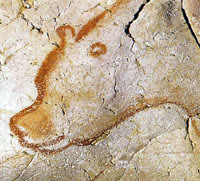Groningen carbon dating fuels debate on prehistoric cave paintings

In 1994 the French speleologist Jean-Marie Chauvet discovered a hidden chamber in a cave near Vallon-Pont d’Arc (Ardèche), the walls of which were covered with drawings of animals. Splendid prehistoric cave paintings, the dating of which led to heated debate among archaeologists.
Carbon dating of the charcoal drawings by a French research laboratory indicated that the figures had to be some 30,000 to 32,000 years old, making them the oldest known cave paintings – twice as old as those in the famous Lascaux cave.
Aesthetic quality
‘Impossible’, says Paul Pettitt, a well-known British specialist in the field of cave art, at the University of Sheffield. In his view, the aesthetic quality of the drawings unmistakably shows that they must be much more recent. Otherwise, says Pettitt, it is as if you are claiming to have found ‘a Renaissance painting in a Roman villa’.
Despite an extensive study in 2001 (Nature, DOI: 10.1038/35097160) which confirmed the earlier French dating, Pettitt’s view remains unchanged.
Charcoal
Even an analysis of the charcoal found among the remains of fires in the cave, most likely used to make the drawings, failed to persuade him. The dating carried out by Prof. Hans van der Plicht in the 14C lab at the University of Groningen also resulted in an age of 30,000 years.
‘Pettitt says that the age of the charcoal does not tell us anything about the age of the drawings’, is how the Groningen carbon-dating expert explains the view of his British colleague. ‘And he has a point; you could still make drawings with it today.’
Cave bears
In a new attempt to settle the dispute, the French palaeogeneticist Jean-Marc Elalouf examined the bones of cave bears found in the Chauvet-Pont d’Arc cave and a cave in nearby Deux-Ouvertures. The Groningen physicist Van der Plicht also contributed to this study that is soon to be published in the Journal of Archaeological Science (now online, DOI: 10.1016/j.jas.2011.03.033).
Besides drawings of cave bears on the cave walls, numerous bones of this long extinct bear species were also found in the Chauvet-Pont d’Arc cave. The ground was littered with them. Elalouf had the age of some of these remains investigated in Groningen using the radiocarbon dating (14C) method. Mitochondrial DNA from the bones was also analyzed.
The DNA material showed little genetic variation – which suggests that the population was small and therefore vulnerable – and the 14C dating showed that the cave bear remains were between 37,000 and 29,000 years old.
Scepticism remains
Despite this new evidence, Pettitt remains sceptical. According to the popular science magazine New Scientist he describes the study as ‘sloppy’ and wonders whether the bears drawn are actually cave bears, or simply ordinary brown bears which were found in the area long after cave bears had become extinct there.
Elalouf’s response is that this last argument doesn’t hold water, because the two species can easily be distinguished by the shape of the head. The cave drawings clearly depict cave bears – a statement which is confirmed by biologists expert in this field.
‘And there’s another thing’, says van der Plicht, who for the purposes of the study visited the cave which is hermetically sealed to the outside world. ‘One of the cave bear drawings has been scratched with a cave bear claw. You would think that this could only have been done by such a bear.’
Although it is difficult to provide definitive proof, the evidence is stacking up, believes Prof. van der Plicht. In his view, the point at which ‘the hard scientific method for dating archaeological finds makes it necessary for archaeologists to change their way of thinking’, is rapidly approaching. ‘And it would not be for the first time.’
More news
-
11 December 2025
Stormy planets and an unexpected atmosphere
-
09 December 2025
Faculty of Impact Grant for new brain cancer treatment
